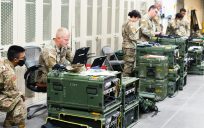The call for cities to embrace open data is getting louder and louder. The recent White House Digital Strategy Initiative is proof of one such example in which they call for all Federal Agencies to be accessible via mobile and have information readily available to the public anytime from any device. Philosophically, we love talking about open data and the concept behind it. But what does that really mean to someone on an everyday basis?
Well, let’s look at Apple.
Recently, Apple announced that they will use their own mapping technology for their new iPhones instead of utilizing Google Maps. There’s just one problem. They don’t have any public transportation information. So that means city dwellers, or anyone who is trying to get somewhere without a car, won’t be given directions on what subway, bus route or rail to take. Maybe that isn’t a problem for someone living in a small town where public transit isn’t readily available, but for someone living or visiting Manhattan, it’s a huge issue.
So why doesn’t Apple have this kind of mapping technology? It’s simple. Cities don’t have these data sets standardized or readily available to the public. That means someone from Apple will have to look up each cities public transit system, record the data, and standardize it so they can incorporate it into their system the way Google did. When you look at the thousands of cities all over the United States and then the rest of the world, it becomes a huge undertaking.
Now, there are some organizations, such as the non-profit group Open Plans, dedicated to funding a new iPhone transit app to alleviate this issue. Yet the problem remains that not all cities have their public transit information readily available to tap into.
The problem doesn’t just end with public transportation. There’s massive amounts of information in every city throughout the world that isn’t accessible via the digital realm. What we continue to hear from municipalities is while they support the open data initiatives, aggregating that data is simply hard to do. It requires an enormous amount of internal resources to dedicate the time needed for such a project. Staff has to clean up data, aggregate it, de-privatize it and more. But even before they do that, there needs to be a common language among cities with regards to how the data should be structured and standardized across the board.
For example, if City A and City B are right next to each other, but store their information, like public transit, in completely different formats, it’s difficult for the everyday user to get clear directions from one city to the other since the formats don’t speak the same language. When you look at the entire ecosystem of municipalities and how they’re all intertwined, you begin to see just how important it is for their language and data sets to understand one another. Speaking the same language isn’t just ideal, it’s imperative.
So at the end of the day, yes Open Gov is important and data standardization is becoming less of a commodity and more of a necessity as we march further into the digital and mobile future. However, given the complexity of such undertakings, we shouldn’t rush cities to open up their data before they’re ready. Instead, we should focus on establishing a set of standards and common language to be agreed upon so that cities know what they’re working towards when they’re ready to release their data. Ultimately, smaller to mid-sized municipalities will look to leading cities, like New York City and the City of Philadelphia, which recently launched a city app and Philly311 mobile request service, to pave the way and establish that standard. It is our calling as leaders in this industry, to help make that transition as easy as possible and guide them appropriately for the greater good.
To begin this process, cities are encouraged to work with existing organizations in the field of data organization to manage the process and bring together cities, categories and other private data sets. Associations like the National League of Cities, Alliance for Innovation and Code for America are great resources for cities to get started. Building public and private partnerships are also beneficial for this purpose. For example, with private organizations, such as ESRI, a robust GIS mapping company, is a great way to tap into existing mapping and transportation data to help bridge the gap in areas where cities may be lacking, and view the format that’s already in use by many other organizations.
To start, municipalities should focus on standardizing top 3 key data sets as identified in the civic app discussion at the Knight Foundation 2012 Conference: business licenses, crime and transit. All three of those data sets are imperative to cities and are greatly intertwined beyond city and county borders. Agreeing to a standard language and format, and tackling that data by priority level, will help all municipalities large and small to satisfy the growing needs of their residents, businesses and visitors.
Are you interested I helping with this effort? Email us to be included in the standardization process atteam@publicstuff.com.




Thanks for calling out the top three datasets. As someone working in local gov innovation, it’s good for me to hear those repeated as priorities.